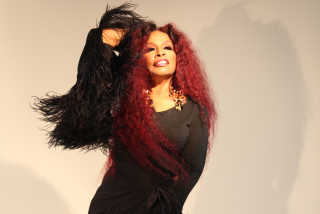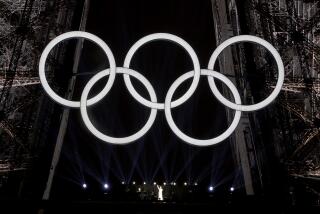The Chosen Fuse: People Who Blow Up Stuff in Movies
When Marty Bresin struts past, you catch a whiff of propane and the unmistakable aura of a guy who thinks he has the baddest job in Hollywood.
With a pair of charred gloves swinging from his hips, Bresin rattles off a career of destruction with the relish of a kid recounting the first time he lit the fuse on an M-80.
There was that fireball at Anaheim Stadium, big enough to briefly blind the folks in the top row. Or the 20,000 gallons of propane detonated in the film “Volcano.” And that Infiniti rigged up for the movie “Three Kings” that exploded, spun in the air and crashed down 6 feet from fleeing actor Spike Jonze.
“A few feet off and the actor would have been history,” said Bresin, who runs his own pyrotechnics company in Encino. “That’s the thing about this work. If lighting messes up, you re-shoot. If pyro messes up, somebody dies.”
Bresin belongs to the small, fearless fraternity of pyro specialists in the Los Angeles area, many of them based in the San Fernando Valley. Considered one of the most dangerous lines of work within the entertainment industry, “pyro” is a subset of the special-effects business that mixes science with daring.
With established pyro specialists making more than $100,000 a year, the best-paying jobs are reserved for those with the most moxie.
As the use of computer effects and electronic gadgetry grows, movie audiences are harder to impress, and pyro specialists say they are under increasing pressure to make live-action stunts more spectacular and--as in Bresin’s case with the flaming, twirling Infiniti--more dangerous.
But basic pyrotechnics hasn’t changed. It’s no easier or safer today than it was 20 years ago to blow up a fuel tank or smash two cars together, pyrotechnicians say.
The core business, conducted in neatly swept workshops from North Hollywood to the Antelope Valley, begins with making bombs, often with materials powerful enough to melt pavement. Each stunt is then carefully rigged to minimize any chance that an actor will get scorched. What’s important is that the stunt goes off as scripted--not always a given.
The thrill is huge; the pressure even bigger. Just before an explosion, with a finger on the detonator and the entire set waiting for the 3-2-1 cue, the pyrotechnician often needs a moment alone.
“We call it pyro bladder,” said Tommy Bellissimo, a Canyon Country effects man who has blown up everything from a ham sandwich to a gas station. “There’s so much nervous energy.”
Behind every big pyro stunt is some form of illusion. Most viewers have seen the cataclysmic scene of a glass tower or skyscraper blowing up. What actually happens, Bellissimo said, is that pyrotechnicians place charges, usually black powder wrapped in electrical tape, in each window and detonate them all at the same time to blow out the glass. Though the building doesn’t get damaged (at least it’s not supposed to), the sequence creates the illusion that the building has exploded.
To create a fireball, pyrotechnicians drop charges into steel caldrons and pour gasoline or diesel fuel on top.
For bullet hits, or “squibs,” as they’re called in the business, pyrotechnicians affix an aspirin-sized explosive to an actor’s shirt and wire the charge to a bag of blood. A thick piece of leather is often slipped under the shirt to protect the actor’s skin, another sign of how pyro still relies on some proven low-tech tricks.
Like other Hollywood trades, pyro is a hands-on skill, in which knowledge is handed down from veterans to rookies. Bellissimo learned his craft from Roscoe Patterson, an effects master best known for making smoke come out of the Tin Man’s hat in “The Wizard of Oz.”
Pyro is also tightly regulated. Before apprentices can handle explosives, they must log two years with a pyro effects company. They must also pass a written exam and a criminal record check, conducted by the state fire marshal’s office, which licenses pyrotechnicians.
To get a first-class pyro license and oversee stunts, it takes another two years, another written exam and an effects demonstration in front of a state fire inspector.
Only 190 people--almost all of them men--are registered in California as first-class pyrotechnicians.
Because they use gunpowder, electronic detonators and even plastic explosives, pyrotechnicians are required to have licenses from the federal Bureau of Alcohol, Tobacco and Firearms to buy their supplies from specially licensed shops. And any production sequence with fire--even down to an interior scene with one candle--requires a pyro permit from the local fire department, according to state law.
Strict licensing has kept the number of accidents down, officials said. Of the approximately 1,500 pyro sequences filmed each year in Los Angeles, only one or two minor injuries are reported, said Al Adams, of the state fire marshal’s office. There hasn’t been a fatality in the last 10 years, he added.
The most recent large-scale pyro disaster was in 1982, during filming of “Twilight Zone: The Movie,” when a special-effects explosion blew the tail rotor off a helicopter, causing it to crash into actor Vic Morrow and two children, killing all three.
Because of the risks, pyrotechnicians typically carry at least $1 million in liability insurance. The top people in the field earn several hundred thousand dollars a year, pyro specialists said.
Money, though, isn’t the point, they say. The thunder of an earthshaking bomb, the thrill of wiring explosives to a $20-million movie star and an above-average dose of pyromania are what drive these people.
“When it comes down to it,” Bresin said, “we’re all here because, at some level, we just love playing with fire.”
More to Read
The biggest entertainment stories
Get our big stories about Hollywood, film, television, music, arts, culture and more right in your inbox as soon as they publish.
You may occasionally receive promotional content from the Los Angeles Times.






